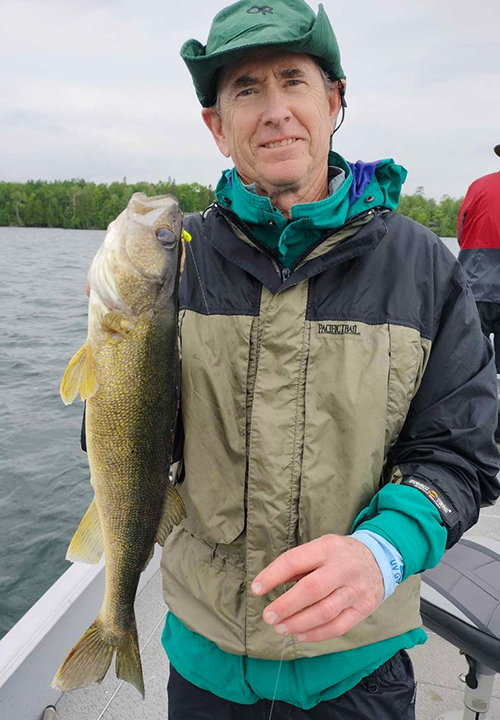Surface temperatures, at their peak reached the high 70 to low 80-degree range. After a cooler, breezier weather pattern developed at mid-week, Winnie’s waters were churned by the choppy water and temperatures settled back in to the 72-to-73-degree range.
The warm water generated a moderate algae bloom and that added some color to the “gin-clear” water in Lake Winnie, which had previously been a problem for walleye anglers on sunny days. There haven’t been any large-scale insect hatches so far, but evidence is mounting that there will be some soon. Walleyes caught on the mid depth flats are coughing up insect larvae in folks’ live wells and tiny white, gnat-like bugs have been hatching over the deep-water mud flats.
The development of submerged vegetation has influenced walleye location too. Earlier this week, walleyes were caught in good numbers by anglers fishing cabbage patches in shallow, 4- to 7-foot-deep water.
With the ever-growing food chain, reduced light penetration, and blooming vegetation, the array of angler’s choices has now widened. Jig and minnow presentations continue to work and are still used by many of our guests. But trolling presentations like spinners and crankbaits are producing fish too. Lindy rigs tipped with lively leeches and night crawlers are also producing fish and so are slip floats combined with live bait. The best rule of thumb for choosing a presentation is to adapt your presentation to the fishing situation you encounter.
Our guide, Jared Saufferer tells us that calm water encourages walleye to move onto breaklines and sand-to-mud transitions. Key water depths there range from 22 to 28 feet of water. Jig and minnow combinations still produce fish, but Lindy Rigs are a good choice here as well.
Saufferer advised that on breezy days, walleyes move up onto sand flats and small rock piles in the 10-to-14-foot depth range. Here, the jig and minnow combination still produce the most action, but slip floats, combined with either ½ night crawler or large leech will produce fish too. Using the slip floats is an excellent way suspend bait above the newly emerging “moss-like” vegetation called Filamentous Algae. The algae clings to jigs, rigs and other lures that encounter it, so suspended baits below a sip float improve efficiency by helping to avoid fouling hooks.
In shallow water, cabbage patches trolling spinners is the key to success. Spinners move through the vegetation when other presentations get snagged and fouled. A #3 Indiana blade, a #2/0 Aberdeen hook and medium size fathead will get you into the action. The spinners are not only great for walleyes, but will trigger other warmer water species like sunfish, crappies, pike, and bass. Speaking of warm water species, many have been very aggressive this week.
Crappies wrapped up their spawning migrations about a week ago and have disappeared from shallow cover. Now, they’ve moved into deeper cabbage and along steep, shoreline related breaks. Daytime activity is minimal, but anglers fishing during late evening or at dawn will find schools of fish roaming the edges of cabbage as they feed. Using small jigs tipped with minnows and suspended below a bobber is one standard tactic. Casting small jigs tipped with plastics is also very effective and so are spinner type jigs like the Beetle Spin, Road Runner or Mepps. Fishing from an anchored position, or with the aid of a spot-locking trolling motor, focus on areas where larger expanses of cabbage meet shoreline breaks that lead into deep water.
Bass, rock bass and sunfish are in various stages of spawning right now. As of Monday, for example, rock bass were solidly pinned to their spawning beds and aggressively defending against intruders, including jig and minnow combinations. Often overlooked as a game fish, rock bass seldom get the respect that they deserve. Some folks do harvest them for dinner, but most don’t, but they are a blast to catch. They are scrappy, eager to strike and in the case of Lake Winnie, come is sizes Extra Large, through HUGE! Fish for them in and around bulrush patches, especially the ones that occur in conjunction with sandy, or hard gravel bottoms.
Largemouth bass and sunfish have been active in shallow water too but are found somewhat deeper. Anglers accustomed to finding them in shallow water spawning cover will be surprised to learn that the warm weather accelerated the process, and many have already moved in, and back out again. Cabbage, coontail and eelgrass patches have been prime examples of their present-day habitat. Fast moving lures like the afore-mentioned spin jigs are a good presentation choice.
Northern pike are active now as well, but not widely targeted yet. Most folk who do harvest them have caught them as a byproduct of walleye fishing. Folks trolling with spinners tend to catch more pike than folks using jigs, and the size potential of fish caught with spinners can often be greater, so this is the preferred “casual presentation”. Folks interested in targeting a larger pike today should consider large minnows, suspended below slip floats.
Late evening, early morning best for crappies
A 30-inch pike may allow your jig or spinner to pass by unmolested, but it will have a harder time saying no to the ’full meal deal”. Use a quick strike rig to present lively sucker minnows in the 8-to-12-inch range and suspend them below a large slip float like Thill’s Big Fish Slider. Focus on patches of healthy green cabbage, and on rock points or rock bars located on the flats.
As summer sets in, fish migrations toward mid-lake structure should begin at almost any moment. We’ll be monitoring conditions and reporting in again next week. If you’re headed for the lake this weekend, good luck and remember, you’re always welcome to stop in to launch your boat, or for a chat.





